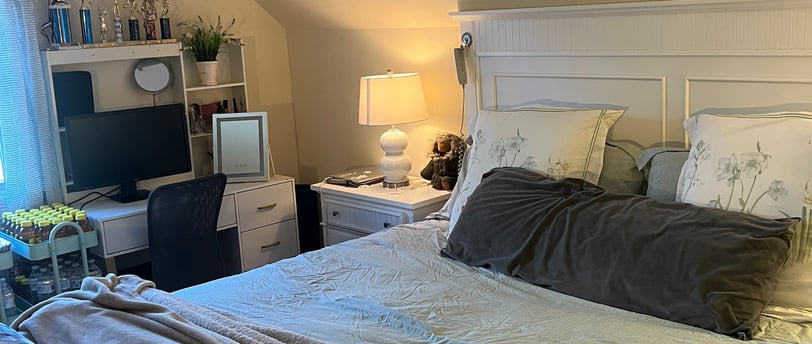Organization Within the Home: Minimalist Living for a Simpler Life


1. What Is Minimalism?
Definition of minimalist living: A lifestyle focused on owning less to make room for more (peace, time, and purpose). Common misconceptions about minimalism. Minimalism often gets misunderstood, which can discourage people from exploring it fully. Here are some of the most common misconceptions and how embracing a shift in values can lead to a more meaningful minimalist lifestyle.
"Minimalism Means Owning Almost Nothing"
Misconception: Many assume minimalism is about living in a bare, white-walled home with only a few possessions.
Reality: Minimalism is not about deprivation. It’s about keeping what adds value to your life and letting go of the rest. Your version of minimalism might look different from someone else’s and should align with your needs and values. By no means is my room bare. I just try not to hold onto this that I don't see myself using in the near future and no longer hold value to me.
Mindset Shift: I focus on quality over quantity. For example, I try not to support fast fashion like Shein or Forever 21. Especially as I get older, I just prefer better quality pieces that are timeless and will last forever.
"Minimalists Don’t Have Fun or Value Comfort and I Cannot Keep My Sentimental Items"
Misconception: Minimalists are often seen as ascetic, rejecting pleasures like hobbies, travel, or decorating their homes. They throw away any and all cherished mementos or family heirlooms.
Reality: Minimalists prioritize what truly brings them joy. For some, that might be vibrant decor, books, or travel experiences. For me that is the case at least. Minimalism myself encourages to keep the items that hold real emotional value and let go of the clutter that doesn’t.
Mindset Shift: Reframe fun and comfort as intentional choices. You can enjoy indulgences as long as they align with your values. If you do not see yourself using an item after a month or two of buying it, maybe leave it on the shelf at the store. Keep a few meaningful pieces and create digital memories of the rest, such as scanning old photos.
"Minimalism Is Too Extreme or All-or-Nothing"
Misconception: People think you have to adopt an extreme, rigid version of minimalism.
Reality: Minimalism is a spectrum, and you can adapt it to your lifestyle. It’s not about perfection; it’s about living with intention. Everything has a purpose in your home or brings some sort of joy.
Mindset Shift: Take small, manageable steps. For example, start with one category (like books or kitchen tools) rather than your entire house. Don't make it feel overwhelming or like a choice, then you will never want to do it. Start at your own pace and stay consistent, maybe put some music on or a podcast while you're decluttering to make it fun!
2. The Benefits of a Minimalist Home
Mental clarity: Less clutter = less mental stress.
Time savings: Cleaning and tidying become faster and easier.
Financial benefits: Spending less on unnecessary items.
Environmental impact: Consuming less is eco-friendly.
3. Minimalist Organization Strategies
Furniture with Storage: Opt for beds, ottomans, and benches with built-in storage. My bed for when I move to the city has pull out drawers' underneath. I also have my rolling storage carts and a versatile clothing rack that work wonders in my space. They are under the "My Reviews" tab on my website if you want to check those out.
Clear Surfaces: Keep countertops, tables, and dressers as empty as possible for a calming effect.
Intentional Placement: Assign everything a “home” to avoid clutter buildup.
One-In, One-Out Rule: Whenever you buy something new, remove a similar item from your home.
Use the “Joy or Utility” test: Keep only what you love or use regularly. Create categories: Donate, Sell, Recycle, Trash.
4. Mindset Shifts for Long-Term Minimalism
Shift #1: You Are Not Your Stuff
Let go of the idea that your possessions define your identity.Shift #2: Memories Aren’t in Things
Keep one memento instead of a box full of items.Shift #3: Practice Gratitude
Appreciate what you have and resist the urge to always want.
Are you ready to embrace minimalist living?
Pick one room to declutter this weekend and see the difference it makes! Share your before and after stories with me on the "Contact Me" section of my webpage on the Home Page. If you made it this far, thanks for reading!
Minimalist Living: Organizing for a Simpler Life.
If you are feeling overwhelmed by the sheer volume of stuff in your home, Minimalist living could be the reset you need. A minimalistic approach to life is acquiring less things and items to make room for more important things like peace and purpose. It is becoming more popular because of the pleasing and aesthetic looks but also because it promotes less consumption and decreases financial pressures in this ever-growing economy. This post will leave you with practical tips and inspiration to begin organizing your home in a minimalistic way.
